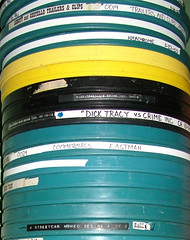Using archive footage: Top 10 tips
 Whether you’re working on a feature film, TV show or commercial, the same rules apply when using archive footage. For both still or moving images, researching and licensing can be a complicated process.
Whether you’re working on a feature film, TV show or commercial, the same rules apply when using archive footage. For both still or moving images, researching and licensing can be a complicated process.
Here are our top 10 tips to help guide you through the world of archive, and hopefully make it a little less daunting…
1. How much archive?
Before you consider using any archive in your project, you should get an idea of how much you want to use. Is it just a few stills? Or in the case of 2010’s Senna, moving footage throughout an entire film. Once this has been decided, you should then look at your licence requirements and budget.
2. What are your licence terms?
Where will your project be shown? Is it a small independent film appearing in a couple of screening theatres? Or is it a TV show airing across the world on various channels, with multiple repeats? This needs to be determined in the very early stages. If you’re working on a TV programme, check what the broadcaster requires in terms of rights.
3. Budget
Once you’ve decided on how much archive you envisage using, and you know your licence terms, you should now look at how much of your overall budget you can put aside for archive. For example, if you plan to feature lots of footage from Hollywood films, you’d better have a big budget set aside as costs for licensing a clip from a movie can run into the thousands.
4. Do a little research
Once you know all of the above, it’s time do a little archive research. There’s no need to hire the best archive researcher in town at this point. Let’s say you’re making a documentary on a famous entertainer, who featured almost entirely on one particular channel. Speak to the channel and find out who made those programmes. Then, contact the company who holds the rights to get an idea of much they charge for licensing footage. Explain to them clearly the outline for your project: how much archive you plan on using; and your licence requirements. This way, you can gauge whether your project is feasible or not.
5. Dead or alive
If you’re focussing on one person who is deceased, it’s crucial to contact their estate at the earliest stage and let them know your plans in order to get permission. The worst situation you can find yourself in is being two months into a project, production team all on board, lovely clips chosen and TX date set, when you hear back from the estate saying they don’t want you to use anything.
6. Hire a good archive researcher
Once you’re ready to start the bulk of the research, it’s time to hire a good archive researcher/producer. You can of course hire one earlier on in the production process, but if you do it’s best to hire them on a short term contract, or at least wait until the production has been fully green lit. A word of warning though: archive is a very specialist area, so researchers and producers who work in this field can charge a lot for their services.
7. Who to use
It’s now time to start contacting the relevant archive libraries. For help with this, The Knowledge has a full directory, ranging from stills to stock footage companies. A lot of these companies allow you to search online, but although this is very handy, it’s far better to speak to someone at the library in the first instance about your project. They may well know of some great footage that is not listed on their site.
8. Communication
It’s crucial you keep regular communication with your line manager. If you’re a researcher, keep your producer up to date with how things are going. If you’re a producer, talk to your exec. Archive can bring up many complications to a project, such as clearance issues. If you’ve found a great clip and everyone in the office is raving about it, but you’re having difficulty getting hold of the copyright owner, make sure you’re producer is aware.
9. Use low res
It’s a big mistake to pay for licensing high-res footage before you’ve even entered the edit. You might have fallen in love with a particular clip or still, only to find you have to exclude it from the final edit because of running time. You should get everything you intend to use on low-res format first; digest it all into your edit, and then you can make a rough-cut. Once you have a clear indication of what you’re going to use, it’s time to start licensing.
10. Licensing
When licensing, or even enquiring about licensing, get everything in writing. You’ll find yourself in hot water when you’re ready to licence a clip or still, only to find the copyright holder meant £5000 and not £500. It’s crucial to save any signed paperwork or emails in an organised system, because when it comes to repeating the project or releasing it on DVD, it’s this paperwork that will be needed.
Are you an archive researcher/producer? Would you like to share any tips with us? If so, why not get comment via our Facebook page.
To get an insight into what it’s like being a film archivist at the BFI, click here to read our interview Jez Stewart, who’s been doing the job for 11 years.


